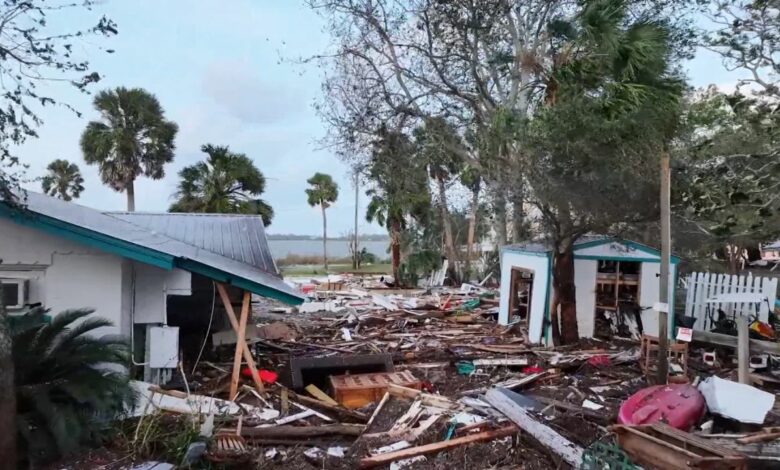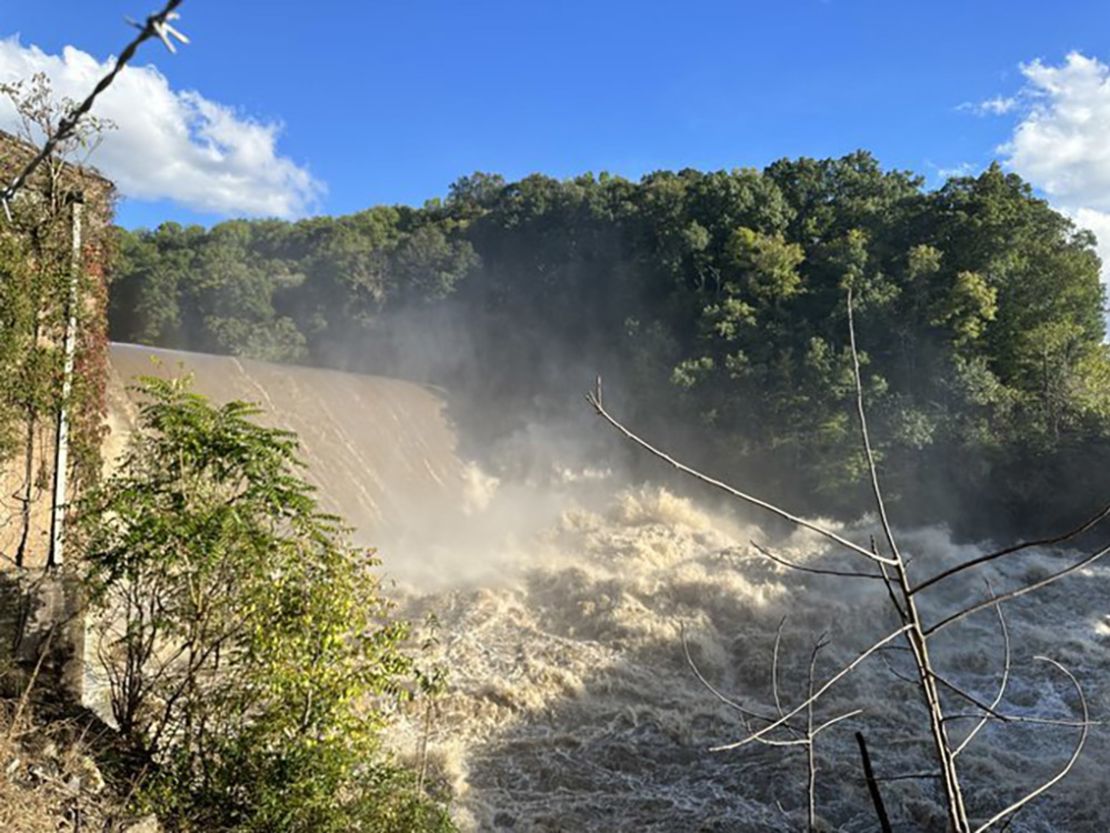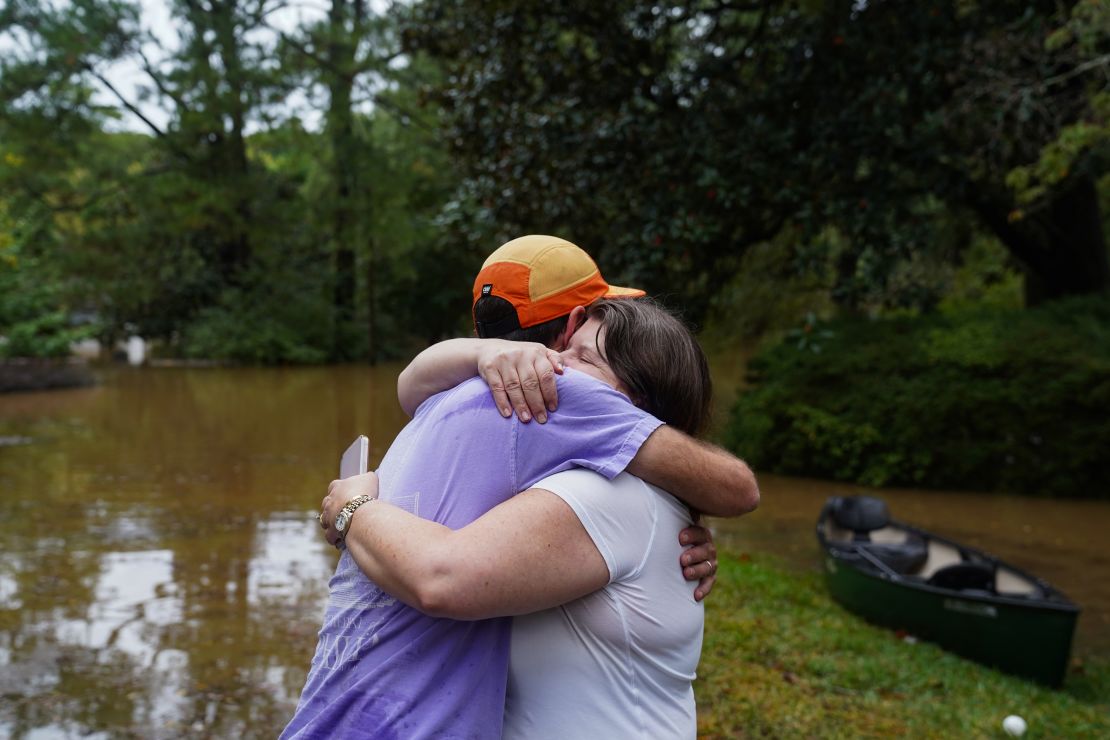
Helene, the strongest hurricane on record to slam into Florida’s Big Bend region, is now a post-tropical cyclone with winds of 35 mph, leaving at least 59 people dead in five states, leveling communities, knocking out power and stranding many in floodwaters following the historic storm’s landfall Thursday night as a monstrous Category 4 hurricane. Here’s the latest:
• Deaths across 5 states: At least 59 storm-related deaths have been reported in South Carolina, Georgia, Florida, North Carolina and Virginia. At least 10 people are dead in North Carolina, a release from Gov. Roy Cooper’s office said Saturday evening. At least 20 are dead in South Carolina, including two firefighters in Saluda County, according to state officials. In Georgia, at least 17 people have died, two of them killed by a tornado in Alamo, according to a spokesperson for Gov. Brian Kemp. Florida Gov. Ron DeSantis on Saturday morning raised the number of confirmed dead there to 11, including several people who drowned in Pinellas County. And in Craig County, Virginia, one person died in a storm-related tree fall and building collapse, Gov. Glenn Youngkin said Friday.
• ‘The worst event in our office’s history’: The National Weather Service Greenville-Spartanburg, South Carolina, said Saturday it is “devastated by the horrific flooding and widespread wind damage that was caused by Hurricane Helene,” and it has “no words” to express the amount of lives lost due to the storm. The agency called it “the worst event in our office’s history,” in a Facebook post Saturday evening.
• Hundreds of roads closed: More than 400 roads remain closed in western North Carolina, the state Department of Transportation said Saturday morning. “All roads in Western NC should be considered closed,” its post on X reads. Multiple sections of Interstates 40 and 26, main thoroughfares for traveling into and out of Asheville, remain closed Saturday either due to flooding or landslides, according to the state Department of Transportation. Since Thursday, Buncombe County has received over 5,500 911 calls and conducted more than 130 swiftwater rescues. Officials warned residents to stay away from the water because of downed power lines, sewage contamination and debris. An emergency shelter is currently serving 400 people at the WNC Agricultural Center near Asheville Regional Airport. The local airport said its operations are “cancelled for the remainder of the day,” and thanked residents for their patience, during the “unprecedented natural disaster.” A curfew remains in effect in Asheville from 7:30 p.m. Saturday to 7:30 a.m. Sunday and will be extended past Sunday, officials said.
• More than 3 million without power: The remnants of Helene continued to knock out power for several states across the eastern US on Saturday, with roughly 3.1 million customers left in the dark in areas like South Carolina, Georgia, North Carolina, Florida and Ohio, according to PowerOutage.us.
• Storm rescue missions underway: There are “multiple fatalities” in Buncombe County, North Carolina, and more than 60 people unaccounted for in the county after the storm brought by Hurricane Helene caused widespread flooding in what officials are calling “biblical devastation” across the area. In hard-hit Buncombe County, which includes the city of Asheville, more than 150 search and rescue operations are underway as emergency services continue to be overwhelmed, said Avril Pinder, the county’s manager, at a Saturday news conference. Ryan Cole, Buncombe County’s assistant emergency services director said there are “multiple fatalities,” at this time but did not have a firm death toll number as of Saturday evening. More than 20 air rescues have been conducted in McDowell County since early Saturday morning, which “successfully extracted patients from isolated areas that remain inaccessible by ground,” the county’s emergency management office said in a news release. McDowell County is directly east of Buncombe County, where Asheville is located. Nearly 4,000 National Guardsmen were conducting rescue efforts in 21 counties across Florida, the Defense Department said Friday. North Carolina, Georgia and Alabama have also activated guardsmen. The Biden administration has also mobilized more than 1,500 federal personnel to support communities affected by Helene, Vice President Kamala Harris said Friday.
• More rain predicted: Additional rainfall is expected this weekend across portions of the southern Appalachian region. Additional totals of up to 1 inch are expected for areas of western North Carolina, including Asheville, and eastern Tennessee, including Pigeon Forge and Gatlinburg. Up to 2 inches is possible for portions of Virginia, Kentucky, Ohio, West Virginia and Pennsylvania through Monday. “Although rainfall amounts will be light, areas that received excessive rainfall from Helene may see isolated aggression of excessive runoff,” the National Weather Service office in Greenville-Spartanburg said Saturday morning.
• Water conservation urged: Residents in the Greeneville, Tennessee, area are being urged to conserve as much water as possible after flooding due to heavy rainfall along the Nolichucky River washed out all the Chuckey Utility District’s water lines crossing the river. Repairs to the water lines are expected to take place “as soon as conditions are safe for everyone,” the utility district said. The North Carolina State Emergency Operations Center is sending potable water to Asheville, as a boil water advisory remains in effect for customers who have water, the city said.
• FEMA chief sees Florida damage: Federal Emergency Management Agency Administrator Deanne Criswell is on the ground in Florida on Saturday, surveying damage and assessing the need for federal resources. FEMA says it has more than 800 deployed staff supporting states affected by the hurricane. “Our distribution centers are fully stocked and ready to provide commodities and equipment to any impacted state as required,” FEMA said in a release. Among those involved are the Department of Homeland Security, the Coast Guard, the Army Corps of Engineers, and the Salvation Army, the release said. The American Red Cross said at least 1,900 people remained at about 80 shelters after evacuation orders were lifted. Criswell is expected to travel to Georgia on Sunday and travel to North Carolina on Monday.
• Severe flooding in North Carolina: Helene “is one of the worst storms in modern history for parts of North Carolina,” Gov. Roy Cooper said. Western parts of the state were slammed by heavy rains and strong winds bordering on hurricane-strength levels, life-threatening flash flooding, numerous landslides and power outages. More than 200 people have been rescued from floodwaters in North Carolina, according to a Saturday update from the governor. Search and rescue operations remain underway as over 700,000 people across the state remain without power. More than 2 feet of rain fell in the state’s mountainous region from Wednesday morning to Friday morning, with Busick recording a total of 29.58 inches in just 48 hours. In the hard-hit city of Asheville, a citywide curfew was in effect until 7:30 a.m. Saturday, officials said. About 20 miles southwest of Asheville, overwhelming, torrential rainfall was pushing the Lake Lure Dam into “imminent failure,” according to the National Weather Service, but Rutherford County officials said early Saturday the dam is no longer at risk. Engineers controlled the flow rate, according to Rutherford County Emergency Management, but the town is still experiencing cell and internet service issues along with roadways blocked by fallen trees and power lines.
• Dam break no longer imminent: A flash flood warning for towns and cities immediately below the Nolichucky Dam on the Nolichucky River Saturday due to dam operators reporting “excessive water flow” over the dam was allowed to expire as water levels receded. The dam had been facing potential imminent breach but no longer is, the Tennessee Emergency Management Agency announced at a noon news conference. The agency worked with Tennessee Valley Authority “to confirm that the Nolichucky is not in that state anymore and that we have no dam failures that are reported at the moment,” TEMA Chief of Staff Alex Pellom said.
• Helene now a post-tropical storm: Helene became a post-tropical cyclone on Friday, but remnant showers continue to swirl across the Tennessee and Ohio Valleys. Multiple areas are approaching more than two feet of rain, with at least 14 different flash flood emergencies issued for approximately 1.1 million people at one point in the Southern Appalachians of Western North Carolina and adjacent parts of Tennessee, South Carolina and Virginia. In addition to the rainfall, winds continued to gust 30 to 50 mph over the Ohio and Tennessee Valley regions Friday evening and more than 35 million people were under wind alerts heading into Saturday.
• Dozens rescued from hospital roof in Tennessee: More than 50 people stranded on the roof of Unicoi County Hospital in Erwin, Tennessee, were rescued after rapidly rising waters from Helene made evacuation impossible Friday morning, Ballad Health said.
• Helene disrupts travel and delivery services: Helene has caused numerous disruptions to travel and delivery services. Several Amtrak trains arriving or departing Florida and Georgia have been canceled, the company said. Delivery services were also impacted, with UPS announcing it has suspended service to Florida, North Carolina and Georgia because of the storm. FedEx likewise suspended or limited its service in five states. Water inundated countless roadways across the region, making them impassable. In North Carolina, 290 roads were closed throughout the state, and Gov. Roy Cooper said the state’s transportation department is shutting down even more roadways as severe flooding, landslides and washed-out roads pose serious threats to public safety.

• Helene is now a post-tropical cyclone: Helene – the strongest hurricane on record to slam into Florida’s Big Bend region – is now a post-tropical cyclone with winds of 35 mph, according to the National Hurricane Center. It means Helene no longer has an organized center of circulation and is losing its hurricane-like features. But this change doesn’t alter much of Helene’s overall threat going forward, as Helene will continue to unleash heavy, flooding rainfall and gusty winds. Keith Turi of FEMA warned residents of the dangers remaining from Helene even after it passes. “There are a lot of dangers in those floodwaters, things you can see and sometimes things you can’t see that are going under the surface, and so really you need to stay out of those floodwaters,” Turi told CNN.

Trapped at home: ‘I really don’t know what to do’
Jennifer Replogle, a pregnant mother of two young children, is “completely trapped” at home in Tater Hill, North Carolina, elevation 4,200 feet, above Boone, where hurricanes are not the norm.
“We weren’t prepared for this,” she said via text early Saturday morning. “The roads are gone, like completely gone.”
Power has been out since early Friday, she said.
Replogle said she has no food and is running out of water.
The few narrow, windy roads from the mountain into Boone are impassable, she said.
“Our basement flooded yesterday. If they don’t get somebody to us soon, I really don’t know what to do,” Replogle said.
She is worried about the plumbing and water services business she and her husband own. They have seen a photo of it with the parking lot flooded and fear “we have lost most of everything.”
Their employees are also “trapped” at home or staying with friends, Replogle said.
Florida and Georgia communities devastated
Helene cut a massive path of destruction across Florida, Georgia and the Southeastern US, snapping trees and power lines, and mangling hundreds of homes. As millions were left without essentials like electricity and some with nowhere to return to after the ravaging storm, rescue crews set out to save people trapped in wreckage or underwater.
In Cedar Key, Florida, the devastation is so widespread, it is not safe enough to allow residents or volunteers back into the small community off the Florida coast, city officials said Friday. The town doesn’t have any sewage water or power, “so there’s really not a whole lot to be able to sustain people being here,” Cedar Key Mayor Sue Colson said.
Scores of historical buildings and new homes have been decimated, while roads were blocked by downed wires and “extremely dangerous” debris, the mayor said. “It’s just a multifaceted mess,” Colson said.
Another small, tight-knit Florida community, Keaton Beach, is picking up the pieces of their lives left behind by the ravages of Helene.
“You look at Keaton Beach … almost every home was destroyed, or the vast majority, and some totally obliterated. It’s because they had such a massive surge that went in there,” Florida Gov. Ron DeSantis said Friday, adding the storm surge might have been as high as 20 feet.
The town’s Beach Bums gas station was three days away from celebrating the five-year anniversary of its opening when it collapsed, said owner Jared Hunt, who spent the morning helping residents look for personal belongings, salvaging what’s left.
One Keaton Beach resident stood with his wife in front of the wreckage of what used to be their home, wondering where they might go next.
“Man, I just lost my house. I have nowhere else to go,” Eric Church told CNN. “My house is laying here in a pile. It was sitting right there. There are just pillars left in the ground. I got a wife and two dogs with me. What am I supposed to do?”
Church’s wife, Erin Peelar, said the couple had just purchased the home and expected some water from the hurricane, not for the house “to disappear.”
“The house has been here for 75 years and that’s the whole reason we bought it six months ago, having faith it would be here for another 75,” Peelar said.

DeSantis said he believes Hurricane Helene inflicted more damage than Hurricane Idalia in 2023, which at the time was the strongest hurricane to make landfall in Florida’s Big Bend region in more than 125 years.
Over in Georgia, multiple people were trapped after at least 115 structures in the southern city of Valdosta in Lowndes County were heavily damaged by Helene, Gov. Brian Kemp said Friday.
“The damage to our community is substantial and appears much worse than Hurricane Idalia,” the Lowndes County Emergency Management said on its Facebook page.
‘Complete pandemonium’ amid North Carolina floodwaters
Residents of Asheville, North Carolina, described “complete pandemonium” in their city after Helene brought several feet of floodwater and pushed large debris into streets overnight.
Samuel Hayes said he woke up with several calls from his employees telling him about fallen trees on their roofs, water pouring into their homes and mudslides.
“Complete pandemonium around the city,” Hayes told CNN’s Isabel Rosales. “It’s going to take us a long time to clean this up.”
Hayes and another Asheville native, Maxwell Kline, described the River Arts District neighborhood as being inundated with oil-contaminated floodwaters.
“A lot of businesses are completely wrecked … I’ve never seen anything like that since I’ve lived here. It’s absolutely a tragedy,” Kline said.
Gas pumps were down and they lost power, internet and cell phone service for hours, they said. “Can’t get anything right now – no food you can buy, no gas, nothing,” Kline said.
About 25 miles outside of Asheville, a lifelong resident of Hendersonville said she was traumatized by the onslaught of Helene. “I never knew anything like this could happen here,” Avery Dull, 20, told CNN.
Dull and her neighbors were “extremely unprepared” for the deluge, and she saw at least one person busting out of their window, she said. But her apartment is still intact because it’s on the second floor, Dull said.
“Luckily we were on high ground, but those people lost everything,” Dull said. “Half of my neighborhood is underwater and dozens of families are trapped inside of their homes. Cars have been completely submerged and totaled, and power is out across the county.”
Elsewhere in North Carolina, shattered glass, rocks and mud covered one couple’s car after a landslide triggered by Helene came crashing down onto Interstate 40 as they were driving through Black Mountain.
Kelly Keffer said her husband saw something coming from the corner of his eye and then they started to hear pounding on top of the car, so he stepped on the gas. Then, the whole side of the mountain started sliding, Alan Keffer said. Alan thought they would be able to speed past it, but it slid faster than he thought.
Within less than a minute, “the rocks, the dirt, everything hit us. It was scary,” he said. The back window was completely shattered, Kelly said.
In Erwin, Tennessee – just over 40 miles north of Asheville, North Carolina – flooding submerged houses, buildings and roadways.
Erwin resident Nathan Farnor said he evacuated the area on Friday afternoon, when his home was slightly above water level, then he fled to an area a few miles away on higher ground.
“The power remains out, and it appears that most businesses, homes, and campgrounds near the river have suffered a total loss,” Farnor said, “Sadly, the situation does not appear to be improving.”
CNN’s Emma Tucker, Elise Hammond, Ashley R. Williams, Taylor Ward, Taylor Romine, Mary Gilbert, Brandon Miller, Alaa Elassar, Nicole Chavez, Josh Replogle, Isabel Rosales, Taylor Galgano, Caroll Alvarado, Sara Smart, Andy Rose, Nic F. Anderson and Paradise Afshar contributed to this report.




